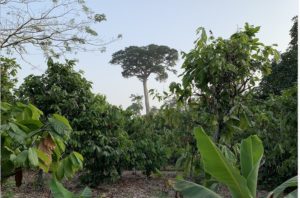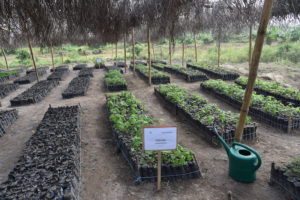One Tree Planted and ICRAF drive major Ivory Coast cocoa sustainability scheme

Photo Gilberte Koffi
A major partnership between the One Tree Planted charity and World Agroforestry (ICRAF) aims to deliver a broad range of 550,000 new trees planted in Ivory Coast to help protect cocoa growing operations that have been stripped of their biodiversity through industrial activity, writes Cathy Watson.
The venture is being carried out with backing from the country’s sector organisation, Le Conseil du Café-Cacao (CCC), and French chocolate company, CÉMOI, in recognition that agricultural practices need to evolve significantly.
As a result, the West African mega-producer is seeking to adopt ‘cocoa agroforestry’ in which the key crop serving the confectionery sector is grown with other species of trees to mimic the natural processes of forests.
One of the first areas to benefit from the project is located in Divo, central Ivory Coast, where World Agroforestry (ICRAF) is booking 200,000 seedlings from nursery operators, with its operators said to be ‘delighted’ at the prospect of joining the venture.
With the country responsible for 40% of the world’s cocoa, it is said to be undergoing a definitive change of practice that marks a full departure from growing cocoa without shade, which has been a major practice as around 80% of the nation’s forests have been eroded since the 1960s directly due to industrial forestry for a number of sectors, including a large element of cocoa production.
The One Tree Plant grant is to enable the raising, planting and follow up of a total of 550,000 diverse additional trees on smallholders’ cocoa farms, which typically have 800–1300 cocoa trees per hectare (picture C Watson).

This will be the first time that cocoa agroforestry is rolled out at scale in West Africa. The aim is to work with 3500 farmers and reintroduce some original forest trees — fruit, nut and timber — as well as a few exotic fruit-tree species, on 14,000 hectares of cocoa land over the next two years.
Industry partnership
Since 2018, ICRAF has worked with both the CCC and CÉMOI in a project called Transparence Cacao, training nursery operators such as Zorom Halidou in Divo, sensitising farmers and cooperatives to the critical function of trees and setting up plots to show that cocoa can grow well with other tree species.
According to CÉMOI coordinator for Divo, Nicholas Yao, Half a Million Trees comes at just the right time. “Our vision under Transparence Cacao is reforestation,’ he said, ‘and this new project with One Tree Planted will help us all go faster.” (planting below, photo Gilberte Koffi).

Cocoa agroforestry was not always an easy sell in Ivory Coast. In the 1970s, full-sun cocoa production was popular, producing high yields. But harvests fell as soil became depleted and bioclimatic conditions changed. A cycle ensued of new farms being opened in forests with their fertile soil, then abandoned, followed by further farms being opened, sometimes in Government forests – and deforestation became a key issue in the country.
Today, however, ‘no more forest lands are available,’ said Christophe Kouame, ICRAF regional coordinator for West Africa, with a broad consensus emerging that there is an urgent need to return at least some of the trees.
‘Ninety-five percent of farmers want trees and they want solutions to how to stay in cocoa, to reduce the mortality of their trees because of poor soil, drought and disease,’ said Kouame, who also leads ICRAF in Ivory Coast.
‘There used to be a lot of rain; now there’s a lot of sun. It tires our cocoa,’ said Wasswa Diallo, one of the around 50 women who pot seedlings at Halidou’s nursery (main image), in Divo (pictured below, photo Gilberte Koffi).

‘When there’s drought and no shade, our cocoa trees die,’ explained farmer Nabole Yabre, who farms seven hectares of cocoa.
For Kouame, the project with One Tree Planted is a perfect way to satisfy the ecological, social and economic need for trees. It is also a culmination of ICRAF’s research on which tree species are most suited to be ‘companions’ to cocoa.
The trees that Half a Million Trees distributes will address the well-known need for shade. But they will also capture carbon, regulate water, increase biodiversity, reduce damage from wind and other weather extremes, and enrich soil through leaf litter and the action of their roots.
Further, their fruits and nuts will boost nutrition and give farmers new income streams. Despite the wealth from cocoa that has made Côte d’Ivoire the largest economy in West Africa, with over a third of cocoa-growing households found to be struggling with two or more months of food insecurity a year. Diets are low in vitamin A and iron.
Lastly, none of the tree species to be introduced are hosts for the vector of the cocoa swollen shoot virus that has laid waste to great swathes of cocoa trees. Côte d’Ivoire is pivoting to more climate- and eco-friendly cocoa. The CCC has thrown its weight behind cocoa agroforestry, calling for 60 million trees in cocoa in the next four years. And a legal change makes tree planting more attractive.
Formerly, timber ‘exploitants’ could extract any tree on any farm, paying very low fees and often damaging cocoa trees. But the new Ivorian Forest Code, promulgated in 2019, states that ‘the ownership of a planted tree belongs to the owner of the land on which they are located or the farmer who planted the tree,” which the ICRAF believes is a huge step forward for the sector.
‘Before they could come to cut but not anymore,’ explained farmer Koli Kouassi. ‘Now, if I need wood, I can cut a tree. But no one else can. The trees belong to me.’
The ICRAF team knows that 550,000 trees planted and growing is no small thing, especially with plans to reach 5000 hectares this year alone. It will also require extensive work with the wider industry, including cocoa cooperatives to which the farmers sell.
– Cathy Watson is chief of Partnerships, Centre for International Forestry Research, and World Agroforestry



